Everybody who has visited Amsterdam knows that this city itself is a piece of art, the engineering techniques used for its constructions have been a state-of-the-art for the past 1000 years. Amsterdam is a worldwide known city, an example of construction and development, as well as a cultural and social referent since its creation.
Amsterdam, literally, a dam in the river Amstel, started as a fisherman town. Thanks to trade came a port around the 12th Century. By the 17th Century this city became an example for the rest of the world, thanks to its progress and technological achievements.

Amsterdam has been on the spot light for several decades thanks to their engineering masterpieces, their complex system of old dikes and modern barriers that keep the water away from their capital and protect the heart one of the most fruitful economies of the world.
What does Amsterdam mean?
The name Amsterdam literally means Dam in the Amstel. This word derivates from the ancient term Amstelredamme, a damn in the river Amstel. This territory, located in the province of North Holland, started its life as a fisherman town that later on, through the centuries, became a port.
Thanks to the development of commerce and their strategic location between European countries, the Northern sea and their position as the delta for all Northern German rivers, they became a nexus for all the frontier territories, like the rest of the Netherlands.
By the Middle Ages, Dutch people, and concretely Amsterdamers, became one of the most powerful finance and diamond dealers of the world.
Origin of the City of Amsterdam
This territory used to belong to Floris V, Count of Holland, who gave many allowances to the habitats of this territory. Among these allowances, he gave permission to the citizens of this land to transport good through the water. Thanks to him and thanks to the bishop of Utrecht, who also created laws protecting and encouraging the rights and permissions of these citizens, the economy grew.
Since the very beginning, water has played a main role in the whole development of this city: starting as a fish village, developing through trading and transporting, and becoming a main port.
Back in the day, the constructions in this territory were made of wood. Most of the buildings were located around the area of where Dam square is located nowadays. Due to the fragility of the material, there are no constructions remaining of this period, only maps, trading books and other documents.
Because of the constant danger of fires, at the end of the 15th Century wood was banished as a building material and more permanent buildings were constructed from that time onwards.
The Golden Ages
This is the best period in the history of the Netherlands. The Golden Ages represent the years of highest cultural and economic growth of the Netherlands, and of course that includes the city of Amsterdam.

In the 16th Century, Amsterdam continued its growth, creating a lot of the structures that still remain part of the city nowadays. Meanwhile, the Protestant Reformation penetrate in the Dutch society throughout the whole Netherlands, despite persecution. This religion would shape the Dutch society since, becoming part of their identity and influencing future political decisions such as the 19th Century pillarization (verzuiling).
In the 17th century, Amsterdam was the principal market of the whole world. During this period the characteristic Amsterdam cityscape developed; the 50 years urban expansions ( between 1613 and 1663) determined the city’s characteristic appearance, buildings, art, markets and most importantly, canals.
Construction
The first canals were created with the purpose of water management and defence. As Amsterdam expanded in the Middle Ages, these canals ended up inside the walls and therefore, they lost their function. Suddenly afterwards they acquired an important new role: local transport of merchandise.
Amsterdam boomed and three great canals were built around the city. This is another one of the main features, characteristics of this city, that started taking place during the Golden Ages. Canals would not only become worldwide known and a part of the Dutch identity, but also a way of commerce.

These canals were Herengracht, Prinsengracht, and Keizersgracht, dug during the Dutch Golden Age. These form a concentric belt around the city, known as the grachtengordel. A point of reference for the world, and a great way of not getting lost when visiting Amsterdam.
Why are canals so relevant for Dutch citizens? Well, besides being their main way of making a living, the constructions were built around them, making their lives depend on these. Besides, back in the day, more goods were moved on boats in the canals, moved by human power, than would even be possible today with trucks along the streets next to the canals.
But it wasn’t only canals! Because some of the most historic buildings, some of the most emblematic ones, date back to this period. Among them the can find: Dam Square’s Royal Palace (not a palace back then), Westerkerk, Zuiderkerk and many characteristic canal houses (De Dolfijn, De Gecroonde Raep, etc.)
Society
During the Golden Ages, the population of Amsterdam grew up to 200,000. Despite the high percentage of mortality of the Middle Ages, the plagues and so on, the population kept steadily growing.
The political situation at the beginning of the 17th Century, the revolts agains the Spanish monarch and the new distribution and autonomy of the Seventeen Provinces of the Netherlands, including North Holland, was beneficial for two groups of immigrants: Sephardi Jews fleeing persecution(made by the Inquisition) in Spain and Portugal for Amsterdam’s relative freedom of religion; and refugees from Antwerp and other Flemish cities, where the Spanish Kingdom was still in charge and ruling. Many more different types of European immigrants, including protestants, also built new lives in Amsterdam, Haarlem and other Dutch cities in this era.
Among these groups of immigrants were many internationally well-connected merchants and intellectuals, artists and religious experts. Holland’s Golden Age could not have happened without them since they had priceless contribution to the Dutch culture and found the pillars for nowadays Dutch society; Approximately, in the year 1600, one in three Amsterdammers was an immigrant.
In particular, the Jewish population lived in what is now known as the Jewish Cultural Quarter, close to the Red Light District. In the middle of it, one can find the Portuguese Synagogue, nearby today’s Waterlooplein. Built in 1675, the synagogue is still in use but is also a touristic place, open for visitors. The impressive interior has not changed since it was built. Therefore, there is no heating or electricity, and in the evenings, the synagogue is lit by more than 1,000 candles as the only illumination source.
Another important event that would later on shape the Dutch society was the creation in 1602 of the Dutch East India Company (VOC). That meant the creation of the world’s first multinational company that gave Holland (and, therefore, Amsterdam) a high position as an economic superpower. The VOC’s main chambers where in Amsterdam. The West India Company followed, trading in with tobacco, sugar cane, gold… and also people.
Slavery was a dark aspect of the Golden Age’s society, and it lasted up to its abolition in 1863. Every year, on 1 July, Amsterdam remembers its part in the slave trade and marks its abolition on this day in 1863.
Art
Art has always been a way of discovering and learning about history, but the case of the Dutch Golden Age Paintings is very special: by the time the rest of Europe’s art still depended on the Church as their main patron, the Dutch were different.
Thanks to their prosperity as merchants, Dutch started having savings and extra money to invest in other aspects of life, such as art. The main patron for Dutch painters, unlike the rest of the world, did not came from a religious background, but were average people who wanted to be recognise as successful and powerful individuals.
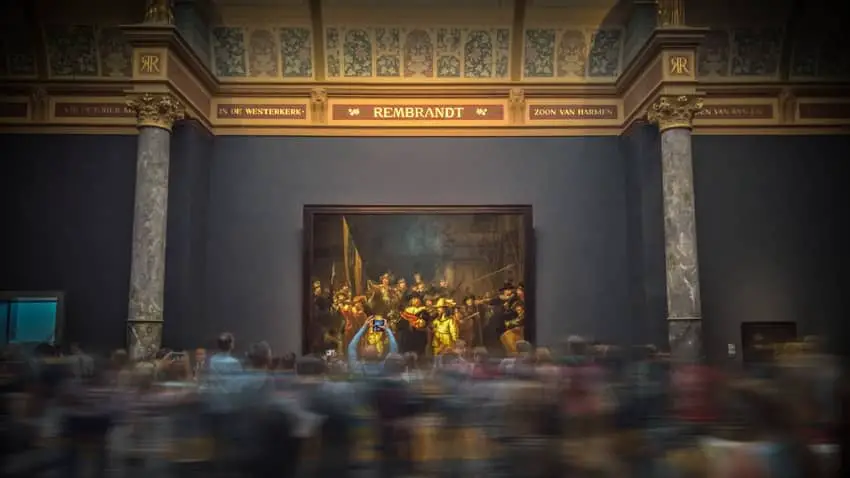
Art became the best way people had to be considered important and portraits and daily life scenes the most popular and requested paintings. The most famous portraits of this period of time are in the collection of the Hermitage: Portrait Gallery. Another one of the biggest collections of art from the Golden Age is in the Rijksmuseum, where one of the most famous portraits of all times hangs: Rembrandt’s Night watch.
Some of the artists that are also worth mention as genius of this period are Jan van Eyck, Albrecht Dürer, and Hieronymus Bosch. You can also book a privately guided tour of the Dutch Golden Ages most famous painting for 75 euros at the Rijksmuseum.
The Night Watch
The most famous and brilliant artistic movement during the Dutch Golden Ages was lead by the Primitive Flemish, Flemish and Dutch painters who would create daily life scenes on their paintings, reflecting the actual world that surrounded them, or those who would create the first accurate portraits. This Dutch masterpiece was made in 1642.
One of the most famous Dutch creation by Rembrandt van Rijn, is the Night Watch, a collective portrait showing a group of Dutch citizens on their duty to protect the city of Amsterdam.
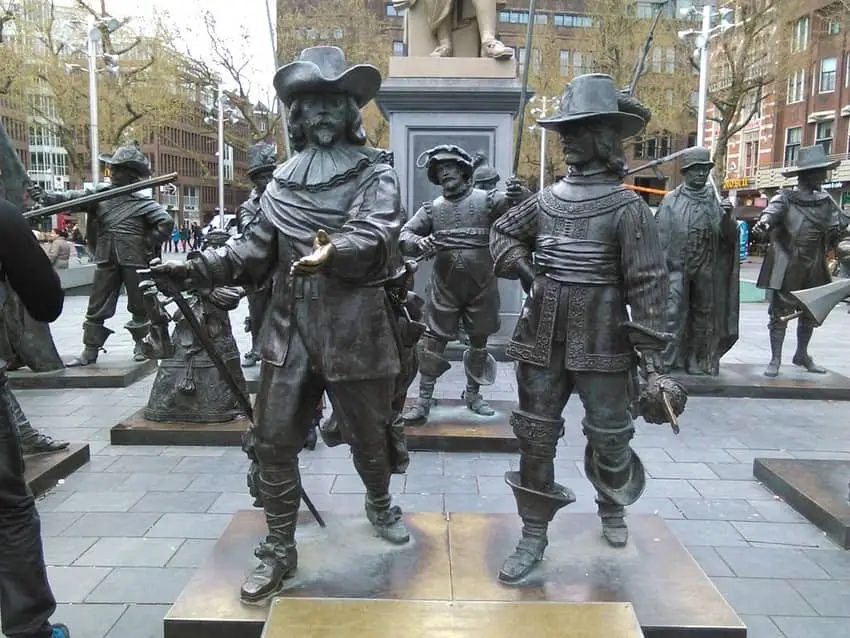
Originally, this painting was called, by the Rijksmuseum, the Civic Guardsmen of District II under the Command of Captain Frans Banninck Cocq. It is not until the 18th Century that the name Night Watch was used. This painting is not only a portrait of the Captain and all the members of the Civic Guardsmen, but also a lot of other figures that give life to the painting.
Decline and New Golden Ages of Amsterdam
At the end of the 17th Century the whole Dutch Republic was attacked, simultaneously, by the Frenchs and the English, making the glorious period of the Golden Ages to finish. However, Amsterdam continued being economically strong and one of the main centres of commerce and management of goods of the old world (more in Local History).
The expansion of the city continued growing with the economy, as well as the construction of more canals in the centre. It wasn’t until the 18th Century that with the definite occupation of the French, Amsterdam suffered from an economic recession, also reflected by the demographic development, meaning, a reduction of growth.
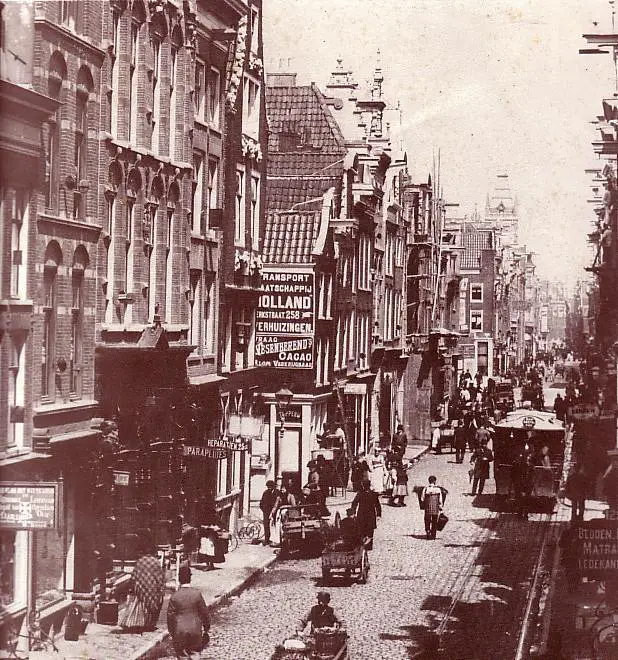
By the end of the 18th Century, and during a more stable situation, Amsterdam started being worldwide known as a city of prosperity and also tolerance. In the 19th Century, during the Industrial Revolution and the new transformations that affected the city, many infrastructures that we can admire nowadays in Amsterdam were constructed. Among them: the Dutch railway system and the Centraal Station (in 1889), the Rijksmuseum (in 1885), the Stedelijk Museum (1895) and Rembrandt’s House as a Museum (1911).
Historical Attractions
If this article has made you curious, or if you are planning on coming to Amsterdam and you are interested on a more substantial holiday, these are the historical places you should visit:
- Amsterdam Museum
- Dam Square
- Rijksmuseum
- Rembrandt Huis
- Westerkerk
- Portuguese Synagogue
- Tuschinski
- Anne Frank’s Huis
- Stedelijk Museum
- Nieuwmarkt
- Homomonument
- And more
Amsterdam Museum: In Kalverstraat 92, from 10am until 5pm, the official Amsterdam Museum is open every single day of the year. Tickets at the entrance or online for around 15 euros.
This museum focuses on the development of the history of Amsterdam, including all types of exhibitions, art, sculpture, architecture and more. One of their most famous exhibitions also includes Golden Age portraits, one of the emblems of Dutch History. There you will be able to follow a chronology of all the main events occurred in the city.
Dam Square: Dam Square, free for the public (not so the Palace or the Old Church’s entrance).
As mentioned before, Dam Square has been an important meeting point of the city, and its surroundings, like the De Bijenkorf, one of the first places were Medieval wooden buildings were constructed. What a contrast!
One of the main characteristics of this square is the Palace, constructed in 1648. It is not the official house of the Royal family and it is open to the public for 10 euros and from 10am until 5pm every day. Another one of the main features of the square is the Obelisk, constructed in 1956 for the memory of all the Dutch soldiers and members of the resistance of the Second World War (more here).
Rijksmuseum: Located in the Museum Square, the Rijksmuseum is open from 9am until 5pm and an adult ticket online costs 19 euros. More information here.
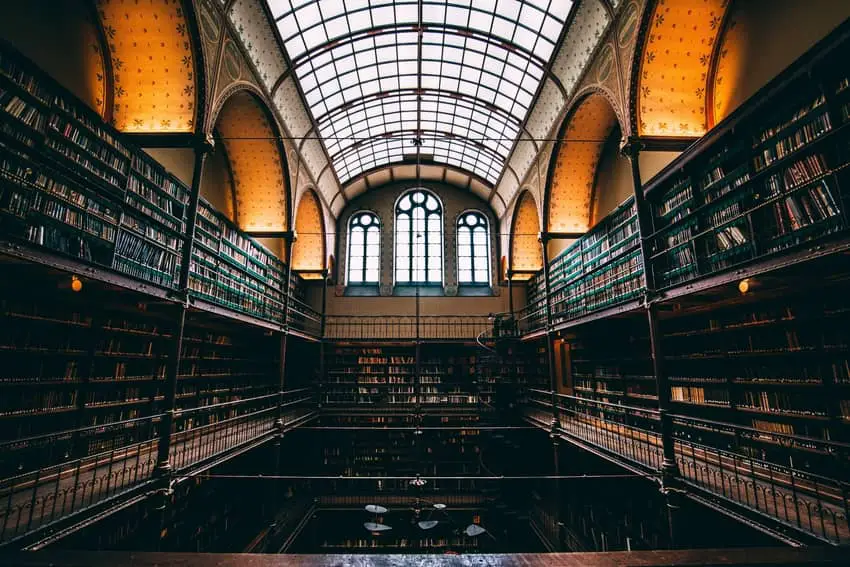
The Rijksmuseum is not only an impressive building and one of the first constructed in the Middle Ages, after the foundation of the city, it is also the house of many masterpieces such as the Night Watch, as we mentioned before.
The Rijksmuseum offers Dutch history, history of the colonies, manuscripts, WWII pieces, and a full room of primitive Flemish creations: The Gallery of Honour has some of the most famous Dutch paintings of the 17th Century. Among these walls there is not only Amsterdam history but all the creation and foundation of the whole country, through the eyes of Pieter de Hooch, Johannes Vermeer, Johannes Cornelisz. Verspronck and many others.
Rembrandt Huis: Located in Jodenbreestraat 4, 1011 NK, close to Zuiderker, is open between 10 am and 6pm every day of the week. The entrance price is 14 euros.
The interior was created in the 17th Century and is one of the oldest buildings of the city that has been kept and restored through the years. It is, of course, the old residence of the most famous Dutch painter of all times, Rembrandt van Rijn. In there you can visit his home and workshop, a collection of Rembrandt’s etchings and sources of inspiration, as well as exhibitions of his predecessors and contemporary artists whose view was inspired by him.
Portuguese Synagogue: Located in Mr. Visserplein 3, 1011 RD, close to Waterlooplein. It is a museum open for visitors who buy the 6,50 euros ticket, from Sunday until Friday (closed for tourists on Saturday), from 10am until 4pm.
One of the important parts of Amsterdam and the Dutch as a culture is the Jewish community. One of the best ways of getting to know it is by visiting the Portuguese Synagogue in the. It is also one of the first buildings constructed in the 16th Century that has lasted miraculously almost intact until now.
Pathé Tuschinski: Reguliersbreestraat 26-34, 1017 CN, close to Muntplein and the Flower market.
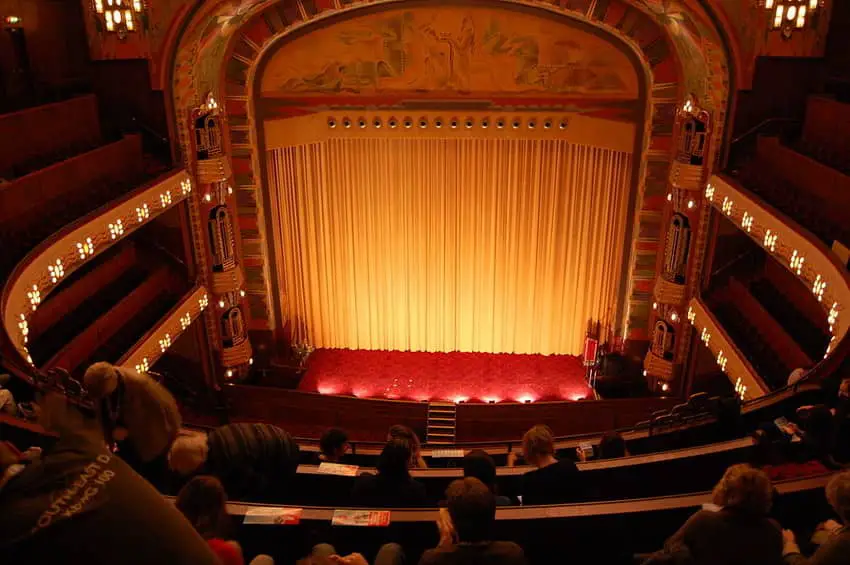
Do you feel like watching a movie? Pathé Tuschinski is an amazing ArtDeco theatre, created in 1920. It is not that much of an old building but it still is historical and the first cinema in Amsterdam. It is also surprising the fact that all the rooms remain the same, and you can wait for your film to start in the lobby, where all the decorations also remain the same.
Anne Frank’s Huis: in Westermarkt 20, 1016 GV, a 10 minutes walk from Dam Square, in de Jordaan. It opens every day from 9am until 10pm and you can get your tickets here.
If there is a famous, historical and emblematic building in the city, this is it. Anne Frank’s house represents the Jewish community, the occupation and her life. Here you can follow a timeline of all the events that happened in her life and all the life of those affected by the Holocaust and the war.